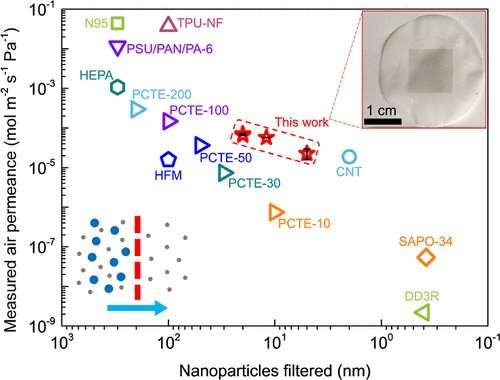New research explores nanotech frontiers to mitigate biological threats and decarbonize transportation

Piran Kidambi, assistant professor of chemical and biomolecular engineering, recently had two papers appear in ACS Applied Materials and Interfaces and ACS Nano that respectively focus on a new approach to filter nanoparticles and explore ways to aid decarbonizing transportation.
The paper published August 29, 2022, in ACS Applied Materials and Interfaces is about developing one atom thick filters that remove nanoparticles down to 5 nm—about 12,000 times smaller than human hair—from air streams. Such filters can enable applications for protecting soldiers and first responders from biological threats. The filters would also be less cumbersome than the devices some of those individuals currently use.
Kidambi said the current HEGA (High Efficiency Gas Absorption) filters in masks often used by soldiers and emergency officials are large, bulky, allow limited air flow and can strain a person's neck during prolonged operation.
"They also often need auxiliary power to force air through the filter because it's so dense," said Kidambi. "We're creating the thinnest possible filters—just one atom. This allows better air flow for breathability and sweat-based cooling but still blocks out particles down to five nanometers in size, much smaller than most viruses or other biological agents."
The other paper published October 6, 2022, in ACS Nano explores ways to create ultra-thin membranes—one atom thick—for efficient and more sustainable transportation. Hydrogen is increasingly being looked at as a source of power because its combustion in a fuel cell releases only water into the atmosphere and not carbon dioxide like gasoline powered vehicles. Scientists believe excessive amounts of carbon dioxide in the atmosphere is the primary cause of global warming and climate change.
State-of-the-art hydrogen fuel cell membranes allow some leakage of hydrogen that lowers fuel cell efficiency. The research published in ACS Nano presents a new approach to address this issue using the one atom thick material graphene.
"We discovered that freezing Angstrom-scale proton selective defects into one atom thick films of graphene can enable next-generation fuel cell membranes," said Interdisciplinary Material Science graduate student Nicole Moehring, first author on the paper. "Stacking two such layers almost eliminated hydrogen leakage compared to conventional fuel cell membranes. We believe our technology offers new solutions to some of the persistent problems in this tech-space."
More information: Peifu Cheng et al, Nanoporous Atomically Thin Graphene Filters for Nanoscale Aerosols, ACS Applied Materials & Interfaces (2022). DOI: 10.1021/acsami.2c10827
Nicole K. Moehring et al, Kinetic Control of Angstrom-Scale Porosity in 2D Lattices for Direct Scalable Synthesis of Atomically Thin Proton Exchange Membranes, ACS Nano (2022). DOI: 10.1021/acsnano.2c03730
Journal information: ACS Applied Materials and Interfaces , ACS Nano
Provided by Vanderbilt University


















